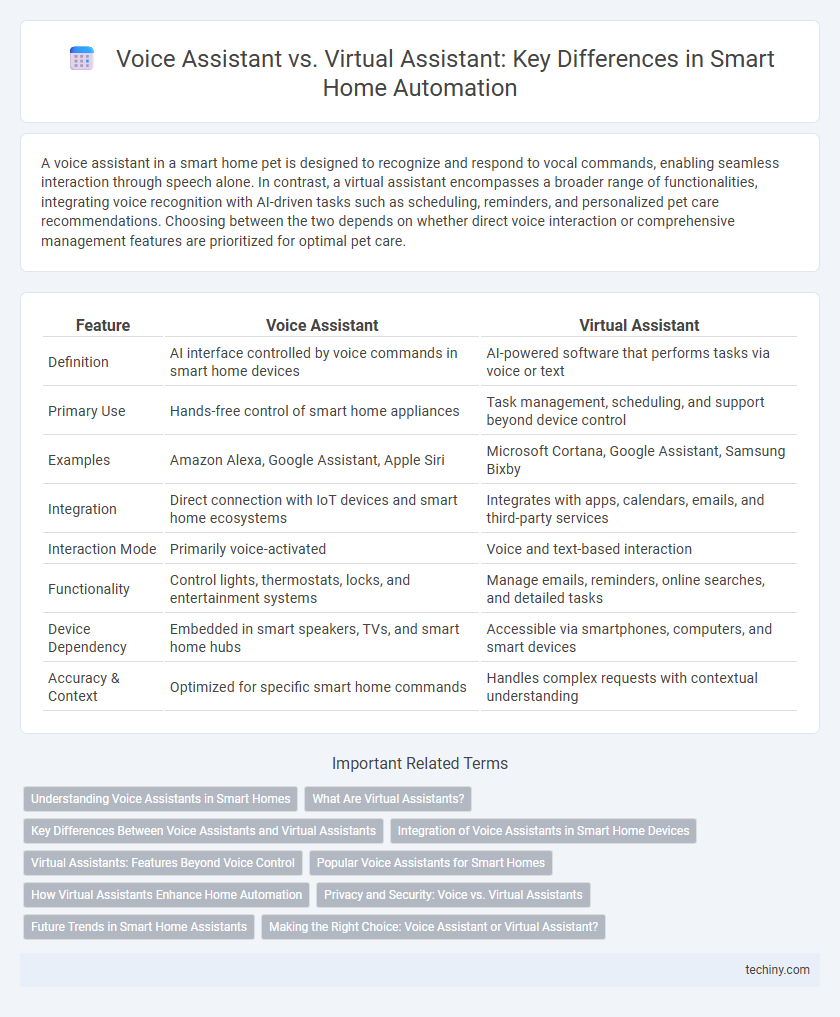A voice assistant in a smart home pet is designed to recognize and respond to vocal commands, enabling seamless interaction through speech alone. In contrast, a virtual assistant encompasses a broader range of functionalities, integrating voice recognition with AI-driven tasks such as scheduling, reminders, and personalized pet care recommendations. Choosing between the two depends on whether direct voice interaction or comprehensive management features are prioritized for optimal pet care.
Table of Comparison
| Feature | Voice Assistant | Virtual Assistant |
|---|---|---|
| Definition | AI interface controlled by voice commands in smart home devices | AI-powered software that performs tasks via voice or text |
| Primary Use | Hands-free control of smart home appliances | Task management, scheduling, and support beyond device control |
| Examples | Amazon Alexa, Google Assistant, Apple Siri | Microsoft Cortana, Google Assistant, Samsung Bixby |
| Integration | Direct connection with IoT devices and smart home ecosystems | Integrates with apps, calendars, emails, and third-party services |
| Interaction Mode | Primarily voice-activated | Voice and text-based interaction |
| Functionality | Control lights, thermostats, locks, and entertainment systems | Manage emails, reminders, online searches, and detailed tasks |
| Device Dependency | Embedded in smart speakers, TVs, and smart home hubs | Accessible via smartphones, computers, and smart devices |
| Accuracy & Context | Optimized for specific smart home commands | Handles complex requests with contextual understanding |
Understanding Voice Assistants in Smart Homes
Voice assistants in smart homes rely on natural language processing and voice recognition technologies to enable hands-free control of devices like lights, thermostats, and security systems. These systems are designed specifically for real-time voice command execution within the home environment, offering seamless integration with IoT devices for automation and convenience. Virtual assistants encompass a broader range of AI-driven functionalities, including task management and personalized recommendations, but voice assistants prioritize immediate interaction through speech recognition and voice-activated responses.
What Are Virtual Assistants?
Virtual assistants are AI-powered software agents designed to perform tasks or services based on user commands through natural language processing. Unlike traditional voice assistants, virtual assistants can manage complex workflows, integrate with multiple smart home devices, and provide personalized assistance by learning user preferences over time. Key examples include Amazon Alexa, Google Assistant, and Apple Siri, which enable seamless control of lighting, security, entertainment, and more within smart home ecosystems.
Key Differences Between Voice Assistants and Virtual Assistants
Voice assistants primarily rely on voice commands to perform tasks such as controlling smart home devices, setting reminders, or providing information through natural language processing. Virtual assistants offer broader functionality beyond voice interaction, often integrating with multiple platforms to manage schedules, handle emails, and execute complex workflows. The key differences lie in their interaction modes, scope of capabilities, and integration depth within smart home ecosystems and productivity tools.
Integration of Voice Assistants in Smart Home Devices
Voice assistants like Amazon Alexa and Google Assistant enable seamless control of smart home devices through voice commands, enhancing convenience and accessibility. Integration of these voice assistants with smart home products allows users to manage lighting, security systems, thermostats, and entertainment systems hands-free. Virtual assistants, though similar, may offer broader AI-driven capabilities but often lack the direct, device-specific integration that voice assistants provide in smart home ecosystems.
Virtual Assistants: Features Beyond Voice Control
Virtual assistants in smart homes offer advanced features beyond voice control, including personalized task automation, contextual awareness, and integration with multiple IoT devices. They leverage machine learning to predict user preferences and optimize home energy management, security, and entertainment systems. Unlike simple voice assistants, virtual assistants provide seamless interaction across platforms, enhancing overall smart home functionality and user convenience.
Popular Voice Assistants for Smart Homes
Popular voice assistants for smart homes include Amazon Alexa, Google Assistant, and Apple Siri, each integrating with various smart devices to enable hands-free control. These voice assistants utilize natural language processing to execute commands like adjusting thermostats, controlling lights, and managing security systems. Their widespread compatibility and continuous updates enhance the convenience and functionality of smart home ecosystems.
How Virtual Assistants Enhance Home Automation
Virtual assistants enhance home automation by integrating with multiple smart devices to create seamless, customizable routines that respond to user preferences and environmental changes. Unlike voice assistants that primarily rely on vocal commands, virtual assistants leverage AI algorithms and contextual awareness to proactively manage energy consumption, security systems, and household tasks. This intelligent automation optimizes comfort, convenience, and energy efficiency within smart homes.
Privacy and Security: Voice vs. Virtual Assistants
Voice assistants like Amazon Alexa and Google Assistant continuously listen to trigger phrases, raising concerns about potential inadvertent recording and data breaches; voice data is often stored on cloud servers, which may be vulnerable to hacking. Virtual assistants integrated into devices or applications typically process commands locally, enhancing privacy by minimizing data transmission and reducing exposure to cyber threats. Users prioritizing security should consider virtual assistants with robust on-device processing to mitigate risks associated with voice-enabled smart home systems.
Future Trends in Smart Home Assistants
Voice assistants like Amazon Alexa and Google Assistant are evolving towards deeper contextual understanding and multimodal interactions, enabling smarter control within connected smart home ecosystems. Virtual assistants are increasingly integrating AI-driven personalization and proactive automation, anticipating user needs to enhance home security, energy management, and comfort. Future trends emphasize seamless interoperability across devices, enhanced privacy features, and AI-powered natural language processing for more intuitive, hands-free smart home experiences.
Making the Right Choice: Voice Assistant or Virtual Assistant?
Choosing between a voice assistant and a virtual assistant depends on the desired level of interaction and automation within a smart home ecosystem. Voice assistants like Amazon Alexa and Google Assistant excel at hands-free control of connected devices through natural language commands, enhancing convenience and accessibility. Virtual assistants, such as Apple's Siri or Microsoft Cortana, offer more personalized task management and integration with productivity tools, making them ideal for users seeking comprehensive digital support beyond voice recognition.
Voice Assistant vs Virtual Assistant Infographic

 techiny.com
techiny.com